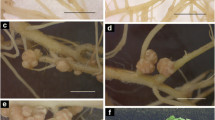Abstract
The fungicide thiram, widely used as a chemical seed protectant, induces a strong inhibition of primary nodulation in the crown zone of soybean roots. The present work reports on the isolation of Bradyrhizobium japonicum strains resistant to thiram, some of which (T3B, A86 and A2) maintained their capacity for nodulation and were still efficient symbionts, but some (A1, C1 and C6) lost the ability to stimulate nodulation. Characterization tests such as growth at different pH, denitrifying ability, salt tolerance, production of siderophores and phosphate solubilization were performed on the resistant strains. Inoculants produced from these strains could be appropriate for use with thiram-treated seeds, without causing a loss of bacteria viability.
Similar content being viewed by others
Author information
Authors and Affiliations
Additional information
Received: 16 September 1996
Rights and permissions
About this article
Cite this article
Andrés, J., Correa, N. & Rosas, S. Survival and symbiotic properties of Bradyrhizobium japonicum in the presence of thiram: isolation of fungicide resistant strains. Biol Fertil Soils 26, 141–145 (1997). https://doi.org/10.1007/s003740050357
Issue Date:
DOI: https://doi.org/10.1007/s003740050357




